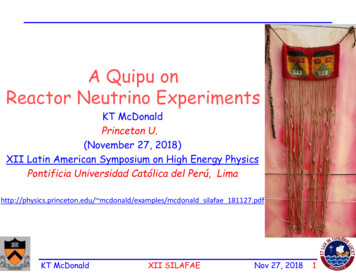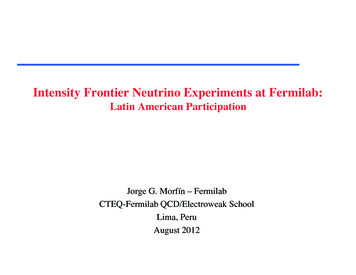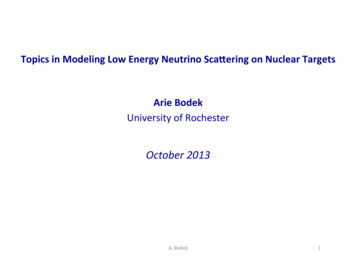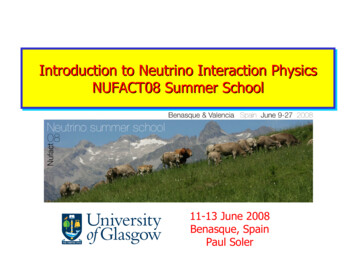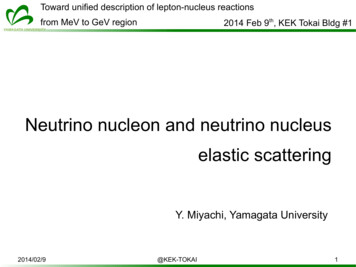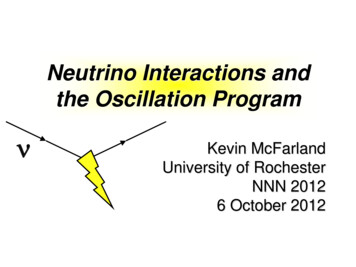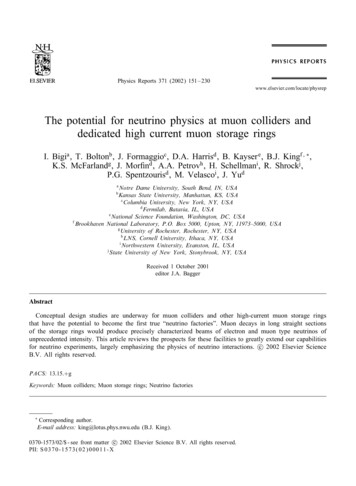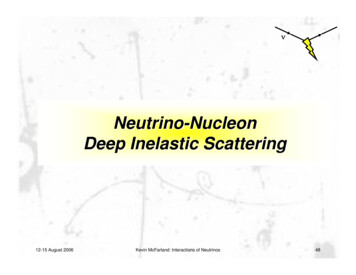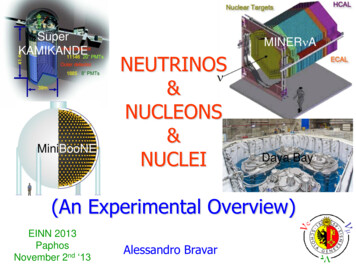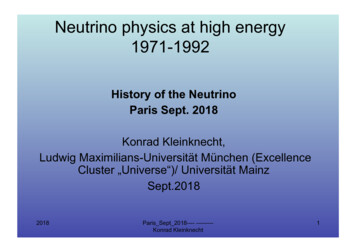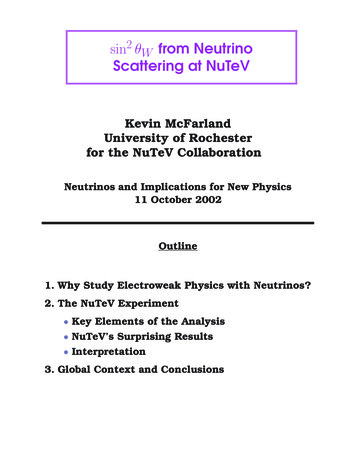
Transcription
¾from NeutrinoScattering at NuTeV Kevin McFarlandUniversity of Rochesterfor the NuTeV CollaborationNeutrinos and Implications for New Physics11 October 2002Outline1. Why Study Electroweak Physics with Neutrinos?2. The NuTeV ExperimentKey Elements of the AnalysisNuTeV’s Surprising ResultsInterpretation3. Global Context and Conclusions
Kevin McFarland, ¾from Neutrino Scattering at NuTeV2The Role of NuTeVNeutrino scattering played a keyhistorical role in electroweak unificationDiscovery of Neutral Current(Gargamelle, FNAL-E1A)First determimation ofhigh-energy parameter in EW theory . . . but why continue to study when wemake copious on-shelland bosonsat colliders? ννZqqTesting in a wide range of processes and momentum scalesensures universality of the electroweak theoryMomentum Transfer (GeV2)0.0001AtomicParityViolation13010000SLAC NuTeVOn-shelle-DW and Z bosonsNuTeV is sensitive to different processes Measurement is off the Z pole (contributions besides Z?) Measure neutral current neutrino couplings LEP I invisible line width is only other precise measurement
Kevin McFarland, ¾from Neutrino Scattering at NuTeV3MethodologyνµννWZqqq Coupling Coupling q Isoscalar target composed of only u,d quarks at tree level:Llewellyn Smith Relation: , easy to measure experimentallyCross-section ratios reduce effects of Experimental systematics, flux Parton distribution functions (PDFs)To extract from the measured ratio: isovector target ( ) heavy quark seas (and kinematic suppression) radiative corrections, higher twist,
Kevin McFarland, ¾from Neutrino Scattering at NuTeV4Heavy Quark EffectsνµννWZµcs,ds,ds,dSuppression of CC cross section for interactions withmassive charm quark in final stateModel: leading-order slow-rescaling ( ) Parameters measured by NuTeV/CCFR in dimuon events(M. Goncharov et al., Phys. Rev. D64, 112006 (2001)) Limits precision of previous N measurements. . . ¾ ¾
Kevin McFarland, ¾from Neutrino Scattering at NuTeV5NuTeV’s ApproachLarge charm production errors need technique insensitive to seaPaschos-Wolfenstein Relation: ν νµ W s , (d V d s ) µ W-cs , dscTeVatron 800 GeV protons is manifestlyinsensitive to sea quarks Charm and strange seaerrors are negligible .(Most of charm from s(x) scattering) Massive charm productionenters fromquarks only .(Cabbibo suppressed and at high x) Separate , beamsµ NuTeV SSQTDecay PipeShieldingSSQT Sign Selected11000011Quadrupole TrainWrong Sign π,ΚDUMPEDNuTeVProtons, KLDUMPEDRight Sign π,ΚACCEPTEDNuTeV
Kevin McFarland, ¾from Neutrino Scattering at NuTeV6Neutral Current/Charged CurrentEvent SeparationEvent LengthνµWq690 Ton CalorimeterqMuon ToroidEvent LengthννZqSeparate by simplelength cut in and beams(1.62 and 0.35million events)q
¾Kevin McFarland,from Neutrino Scattering at NuTeV7Summary of Corrections to Corrections Applied to DataÆ Æ EffectControl Cosmic Ray Background –0.0036 –0.019 Beam Background 0.0008 0.0012 Vertex Efficiency 0.0008 0.0010 Effects in Monte Carlo that relateEffectShort CC Backgroundnu nubar Electron NeutrinosLong NCCounter NoiseHeavyÆ –0.068–0.021 0.0028 0.0044–0.0052–0.0026 EM Radiative Correction 0.0074Weak Radiative Correction –0.0005d/u–0.00023Higher Twist–0.00012 Recall: ! Æ to –0.026–0.024 0.0029 0.0016–0.0117–0.0092 0.0109-0.0058–0.00023–0.00013 Control , , , , , and measured to a precision of0.0013 and 0.0027, respectively : Determined from data : Checked with dataKey to coping techniques: Independent Simulation :technique
Kevin McFarland, ¾from Neutrino Scattering at NuTeV8 Charged-Current BackgroundHigh " charged-current is background to NC sample NC & CC quark modelcross-section term added to , to describe PDFs extracted from CCFROther data determines,, , higher twist, # Data-driven: uncertainties come from measurementsCheck by looking at “long exit” CC events which startin the detector center and stop before toroid
Kevin McFarland, ¾from Neutrino Scattering at NuTeV9Electron NeutrinosApproximately of all short events are It would take a mistake inExcess of over Vast majority of to move CC.to SM value in beam is due to % / in decay/ beams and charm decay, which make both% decay is very well understood and , are small production. . . is constrained byandflux Use predicted flux (few % shifts from production data),except high energy tail ( GeV direct measurement)Have (less precise) direct measurements of : ( ), ( ) ( and GeV)
Kevin McFarland, ¾from Neutrino Scattering at NuTeV10Stability of (cont’d) vs. length cut: Checks NC CC separation“16,17,18” L is default: tighten loosen selection vs. “radial bin”: Checks electron neutrino and short CC eventsMore NC background near edgeNuTeV Target, 60"x60"12345"Radial" Bins
Kevin McFarland, ¾from Neutrino Scattering at NuTeV11Stability of (cont’d) vs.& :Checks stability of final measurementover full kinematic rangeChecks almost everything - backgrounds, flux, detector modeling,cross section model, .(Green band is systematic uncertainty)
Kevin McFarland, ¾from Neutrino Scattering at NuTeV12The Result ' ' ' " In good agreement with previous N: Standard Model fit (LEPEWWG):' 0.2277 0.0031'SOURCE OF UNCERTAINTYData StatisticsMonte Carlo StatisticsTOTAL STATISTICS FluxInteraction VertexShower Length ModelCounter Efficiency, Noise, SizeEnergy MeasurementTOTAL EXPERIMENTALCharm Production, Higher TwistRadiative CorrectionsCharm SeaNon-Isoscalar TargetTOTAL MODELÆ ¾ 000100.000050.00064 Æ 000050.000040.00101 Æ 000040.000040.00212TOTAL UNCERTAINTY0.001620.001300.00272 In the end, why is NuTeV so muchmore precise than CCFR? method makes charmproduction error small Few because of beam greatly reduced
¾Kevin McFarland,from Neutrino Scattering at NuTeV13Comparison to Direct ((Given the precise measurement of the Z mass from LEP. . . . . can express NuTeV as an equivalent 80.433 /- 0.079CDF80.483 /- 0.084D080.471 /- 0.049ALEPH*80.401 /- 0.066DELPHI*80.398 /- 0.069L3*80.490 /- 0.065OPAL*80.451 /- 0.033Direct World Average80.376 /- 0.023Indirect World Average(LEP1/SLD/APV/mt)(LEPEWWG)80.136 /- 0.084NuTeV* : Preliminary80.080.280.480.6Mw (GeV)In standard electroweak theory, NuTeV precision iscomparable to a single direct measurement of More inconsistent with direct(( than other data
Kevin McFarland, ¾from Neutrino Scattering at NuTeV14 Quark Couplings: ¾ and ¾ 2 parameter fitto , : NuTeV measures: Assuming predicted coupling, ) appears low
Kevin McFarland, ¾from Neutrino Scattering at NuTeV15Interpretations Symmetry violations in QCD q New Interactions Neutral current coupling of? ¾ qZνÏ ( N)ν
Kevin McFarland, ¾from Neutrino Scattering at NuTeV16Symmetry Violating QCD EffectsPaschos-Wolfenstein, and momenta equal in targetAssumes sea momentum symmetry, and Assumes nuclear effects common in / exchangeAssumes totalViolations of these symmetries can arise from1. , e.g., high neutron excess (CORRECTED)Changes / of targetmean NC couplingLarge correction, ' , known precisely frommaterial survey, chemical assay of target2. Isospin violating PDFs, e.g., Changes / of target mean NC coupling(Sather; Rodinov, Thomas and Londergan; Cao and Signal)3. Asymmetric heavy seas, e.g., Strange sea doesn’t cancel in (Signal and Thomas; Burkhardt and Warr; Brodsky and Ma)4. Nuclear Effects Different for NC/CCChanges , directlyShadowing region (low ), EMC region (high )(Thomas and Miller; Schmitt et al; Kumano)
Kevin McFarland, ¾from Neutrino Scattering at NuTeV17Symmetry Violation in the NucleonStrange-Antistrange Sea Asymmetry If' Æ , ' (!(S. Davidson et al. ,hep-ph/0112302)Significant overestime of effect on ) But NuTeV dimuon data measures , separatelyin cross-section model used in measurement Æ ' ' ' ' ' above SM)Then ( '' Isospin symmetry violations! !Small nucleon isospin is established;LARGE isospin violation needed to explain NuTeV, # Bag modelMeson Cloud modelThomas et al. , Mod. Phys. LettȦ9, 1799.Cao & Signal, Phys. Rev. C62, 015203. Æ shifts at high, low cancel Æ Are models trustworthy? Can global fits accomodatelarge isospin violation to explain NuTeV?
Kevin McFarland, ¾from Neutrino Scattering at NuTeV18Process-Dependent Nuclear Effects0.0011.1234 5 670.01234 5 670.1234 5 6711.1Nuclear effects onPDFs are largeNuTeV analysis usesonly PDFs on iron1.0F2(X) / F2(D)1.00.90.9NMC Ca/DSLAC E87 Fe/DSLAC E139 Fe/DE665 Ca/DParameterizationError in parameterization0.80.80.70.70.001234 5 670.01234 5 670.1234 5 671xWhy believe these effects areprocess independent?Models: e.g., Pomeron description of high shadowing* NMC High * data showspredicted * behavior # supports pictureNo independent test of NC
Kevin McFarland, ¾from Neutrino Scattering at NuTeV19Process-DependentNuclear Effects (continued)VMD predicts nuclear shadowing different for, (G. Miller and A. Thomas, hep-ex/0204007) No evidence for predicted #* behavior in NuTeVkinematic region ' (NMC) Effect would increase , Low effect cancels in Interesting idea, but. . .inconsistent with NuTeV
Kevin McFarland, ¾from Neutrino Scattering at NuTeV20New Tree Level Physics?ννν“Natural” interpretation of resultq , *, etc.?qqνqMust enhance LL not LR coupling& accounts for NuTeV? Contact terms shift LR coupling Mixing (here ) toseverelylimited by LEP/SLD , ( !" , )(Cho et al., Nucl. Phys. B531, 65.Zeppenfeld and Cheung, hep-ph/9810277.Langacker et al., Rev. Mod. Phys. 64 87.)“Almost sequential”coupling to with opposite NuTeV preferred mass range: TeV CDF/D0 limits: ËÅ GeV. LEP II?¼Contact interaction with LL coupling -- ' TeV Consistent with other .–- data? (Barger,Cheung,Hagiwara,Zeppenfeld) Depends on: Lepton RH couplings How seriously one takes – discrepancies in this data(“CKM unitarity”, , APV?)
Kevin McFarland, ¾from Neutrino Scattering at NuTeV21Neutral Current Interactions LEP I measures lineshape and decay partial widthsto infer the “number of neutrinos” Their result is LEP I “direct” partial width ( # # ) scattering (CHARM II et al.) PDG fit: , cf. predicted NuTeV can fit for a deviation in & NC rate 1.00 /- 0.051.00 /- 0.020.995 /- 0.0030.988 /- 0.004 ! CHARM II et al.LEP I DirectLEP I LineshapeNuTeV0.960.981.001.02Neutrino NC Rate/PredictionIn this interpretation, NuTeV confirms and strengthensLEP I indications of “weaker” neutrino neutral current NB: This is not a unique or model-independent interpretation! Theoretically awkward to accomodate without changing " #vertex as well Latter is possible? (T. Takeuchi, hep-ph/0209109)
Kevin McFarland, ¾from Neutrino Scattering at NuTeV22Global EW Fit (LEPEWWG)Measurement(5)Pull αhad(mZ)0.02761 0.00036-.27mZ [GeV]91.1875 0.0021.01ΓZ [GeV]2.4952 0.0023-.42σhad [nb]041.540 0.0371.63Rl20.767 0.0251.050.01714 0.00095.700.1465 0.0033-.53Rb0.21646 0.000651.06Rc0.1719 0.0031-.110,bAfb0,cAfb0.0994 0.0017-2.640.0707 0.0034-1.05Ab0.922 0.020-.64Ac0.670 0.026.060.1513 0.00211.50sin θeff (Qfb) 0.2324 0.0012.860,lAfbAl(Pτ)Al(SLD)2 leptmW [GeV]80.451 0.0331.73ΓW [GeV]2.134 0.069.59mt [GeV]174.3 5.12 sin θW(νN)0.2277 0.0016QW(Cs)-72.39 0.59measfitmeas(O O )/σ-3 -2 -1 0 1 2 3-.083.00.84 ' ) -3 -2 -1 0 1 2 3Without NuTeV: / # ' # ( probability)With NuTeV: / # ' # ( 'probability) %&problem persists ( Choices are made in selecting data, e.g., combined from , data massaged post hoc but not from “%”
Kevin McFarland, ¾from Neutrino Scattering at NuTeV23The Higgs Mass( Chanowitz, Phys.Rev.Lett. 87 (2001) 231802, in preparation ) : / /dof ' # ( , ( consistent) Higgs in LEP 2 range NuTeV:/ /dof ' # dominates ! %&'dependence !resolving powerof NuTeV is less'Chanowitz “Lose-lose” theorem: Removing data that drives high / would driveHiggs mass further into LEP 2 excluded region
Kevin McFarland, ¾from Neutrino Scattering at NuTeV24The Higgs Mass (cont’d)FitW/o NuTeV, W/o NuTeVW/o W/ All Confidence Level of FitEquiv.CL( ) CL( ' ) Product Significance0.65 0.0350.0222.30.110.250.0282.10.046 0.070.00322.90.011 0.290.00322.9/!(M. Chanowitz, in preparation)Can we fix consistency of data? models “Beautiful mirrors”(Erler and Langacker, Phys.Rev.Lett.84 (2000) 212)(Choudhury, Tait, Wagner PRD65 (2002) 053002)Is this really worth worrying about?60.1% probabletheory uncertainty α(5)had 0.02761 0.000360.02747 0.00012 χ242161% probableExcluded020Preliminary100400mH [GeV]128 χ240Provocative? Sure. . .But it is a fair comparisonof two hypotheses: 10%probable1. Electroweak standard modeldescribes all data2.!'()) 0 GeV2χMedian/15 dof
Kevin McFarland, ¾from Neutrino Scattering at NuTeVSurprise!Conclusions NuTeV measures ,to precisely determine The SM predicts ' ' 25 '' , but we measure: ' " NuTeV consistent with earlier data Neutral-current couplings of neutrinos suspect?Global Electroweak fit is now quite unhealthy also discrepant Other concerns at pole: ( , ? Off-pole: --?, “CKM Unitarity”? %& ( * Atomic parity violation?Without a smoking gun for new physics. . . Interpretation remains a Rorschach test1 A complicated consequence of mundane physics?1 Or might experimental results be pointing toTeV scale physics?
Kevin McFarland, ¾from Neutrino Scattering at NuTeV26BACKUP: Neutron Beta DecayPERKEO II(Heidelberg-ILLGSI-Mainz)If %is universal, 3-generation unitarity. . .' away from expectation!.
Kevin McFarland, ¾from Neutrino Scattering at NuTeV27BACKUP: Higgs Mass Range ofLEPEWWG VariablesΓZ [GeV]0σhad [nb]R0l0,lAfbAl(Pτ)0Rb0RcA0,bfbA0,cfbAbAcAl(SLD)2 leptsin θeff (Qfb)mW [GeV]ΓW [GeV]sin2θW(νN)QW(Cs)110102MH [GeV]103104
Kevin McFarland, ¾from Neutrino Scattering at NuTeVAContents1. from Neutrino Scattering at NuTeV . . . . . . . . . . . . . . . . . . . . . . . . 12. The Role of NuTeV . . . . . . . . . . . . . . . . . . . . . . . . . . . . . . . . . . . . . . . . . . . . . . . . . .23. Methodology . . . . . . . . . . . . . . . . . . . . . . . . . . . . . . . . . . . . . . . . . . . . . . . . . . . . . . 34. Heavy Quark Effects . . . . . . . . . . . . . . . . . . . . . . . . . . . . . . . . . . . . . . . . . . . . . . . 45. NuTeV’s Approach . . . . . . . . . . . . . . . . . . . . . . . . . . . . . . . . . . . . . . . . . . . . . . . . . 56. Neutral Current/Charged CurrentEvent Separation . . . . . . . . . . . . . . . . . . . . . . . . . . . . . . . . . . . . . . . . . . . . . . . . . . . . . 67. Summary of Corrections to . . . . . . . . . . . . . . . . . . . . . . . . . . . . . . . . . . . 78. Charged-Current Background . . . . . . . . . . . . . . . . . . . . . . . . . . . . . . . . . 89. Electron Neutrinos . . . . . . . . . . . . . . . . . . . . . . . . . . . . . . . . . . . . . . . . . . . . . . . . . 910. Stability of (cont’d) . . . . . . . . . . . . . . . . . . . . . . . . . . . . . . . . . . . . . . . . . 1011. Stability of (cont’d) . . . . . . . . . . . . . . . . . . . . . . . . . . . . . . . . . . . . . . . . . 1112. The Result . . . . . . . . . . . . . . . . . . . . . . . . . . . . . . . . . . . . . . . . . . . . . . . . . . . . . . . . 1213. Comparison to Direct . . . . . . . . . . . . . . . . . . . . . . . . . . . . . . . . . . . . . . . 1314. Quark Couplings: and . . . . . . . . . . . . . . . . . . . . . . . . . . . . 1415. Interpretations . . . . . . . . . . . . . . . . . . . . . . . . . . . . . . . . . . . . . . . . . . . . . . . . . . . 1516. Symmetry Violating QCD Effects . . . . . . . . . . . . . . . . . . . . . . . . . . . . . . . . 1617. Symmetry Violation in the Nucleon . . . . . . . . . . . . . . . . . . . . . . . . . . . . . 1718. Process-Dependent Nuclear Effects . . . . . . . . . . . . . . . . . . . . . . . . . . . . 1819. Process-DependentNuclear Effects (continued) . . . . . . . . . . . . . . . . . . . . . . . . . . . . . . . . . . . . . . . . 1920. New Tree Level Physics? . . . . . . . . . . . . . . . . . . . . . . . . . . . . . . . . . . . . . . . . . 2021. Neutral Current Interactions . . . . . . . . . . . . . . . . . . . . . . . . . . . . . . . . . . . 2122. Global EW Fit (LEPEWWG) . . . . . . . . . . . . . . . . . . . . . . . . . . . . . . . . . . . . . . . 2223. The Higgs Mass . . . . . . . . . . . . . . . . . . . . . . . . . . . . . . . . . . . . . . . . . . . . . . . . . . 2324. The Higgs Mass (cont’d) . . . . . . . . . . . . . . . . . . . . . . . . . . . . . . . . . . . . . . . . . 2425. Conclusions . . . . . . . . . . . . . . . . . . . . . . . . . . . . . . . . . . . . . . . . . . . . . . . . . . . . . . 2526. BACKUP: Neutron Beta Decay . . . . . . . . . . . . . . . . . . . . . . . . . . . . . . . . .2627. BACKUP: Higgs Mass Range of LEPEWWG Variables . . . . . . . . . . . 27
from Neutrino Scattering at NuTeV 21 Neutral Current Interactions to infer the LEP I measures lineshape and decay partial widths “number of neutrinos” Their result is LEP I “direct” partial width ( ) # scattering (CHARM II et al.) PDG fit: ,cf. predicted NuTeV can fit for a deviation in & NC rate !
